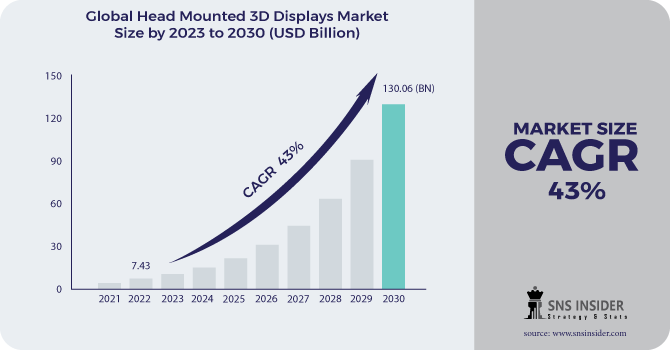Head Mounted 3D Displays Market Size :

Get more information on Head Mounted 3D Displays Market - Request Sample Report
The Head Mounted 3D Displays Market Size was valued at USD 10.62 Billion in 2023 and is expected to reach at USD 265.67 Billion by 2032 and grow at a CAGR of 43% over the forecast period of 2024-2032.
Head Mounted 3D Displays Market usually has one or two small mirrors, with lenses and mirrors embedded in eyeglasses, visors, or helmets. The display units are made of miniaturized and can include cathode ray tubes, liquid-crystal displays, liquid crystal in silicon, or organic light-emitting diodes. Some retailers use many smaller displays to increase overall clarity and viewing space. Head Mounted 3D Displays differ in that they can only display computer-generated images, or only live images from the physical world, or a combination. Most Head Mounted 3D Displays can only display a computer-generated image, sometimes called a virtual image. Some Head Mounted 3D Displays may allow CGI to be placed at the top of the real world view. This is sometimes called augmented reality (AR) or mix reality (MR). Combining real world views with CGI can be done by displaying CGI with a mirror that shows the part and real world view. This method is often called optical see-through. Combining real-world and CGI views can also be accomplished electronically by receiving video from the camera and mixing it with CGI.
Head Mounted 3D Displays Market Dynamics:
KEY DRIVERS:
-
Increase in the investments toward the development of Head Mounted 3D Displays Market.
-
AR is being adopted by industries such as consumer electronics, aerospace and defence, healthcare, retail, and advertising due to its benefits.
RESTRAINTS:
-
User experience and product development information.
-
Lack of rating causes problems for interaction between products from different vendors.
-
Head-mounted 3D displays, VR, and AR require similar standards that allow developers to create open and interactive applications.
OPPORTUNITIES:
-
High level of penetration into video games.
-
produce digital images, allowing 3D viewing to enhance user experience by displaying images and game screens as real-world images.
-
Companies are introducing a wide range of AR and VR games.
CHALLENGES:
-
The placement of locks and segregation mechanisms.
-
Disrupted the Head-mounted 3D display market.
IMPACT OF COVID-19:
The head-mounted 3D display market includes major Tier I and II providers These suppliers have their production facilities spread across various countries throughout the United States, Europe, APAC, and RoW. COVID-19 has had an impact on their businesses.The outbreak has had a negative impact on the head-mounted 3D display market, as some of the leading players are based in China, the origin of the epidemic. Moreover, in view of the current situation, key market players are currently focused on maintaining and generating operational capital, which has reduced the number of market developments
REGIONAL ANALYSIS:
The market is divided into five regions: North America, Europe, Asia Pacific, Latin America, and the Middle East and Africa (MEA). North America has also been divided into countries such as the United States and Canada. The European region is also divided into the United Kingdom, France, Germany, Italy, Spain, Russia, and Europe as a whole. China, Japan, South Korea, India, Australia, South East Asia, and the rest of Asia Pacific are also subdivided. The Latin American region is further subdivided into Brazil, Mexico, and the rest of Latin America, while the Middle East and Africa region is further subdivided into GCC, Turkey, South Africa, and the rest of MEA.
Get Customized Report as per your Business Requirement - Request For Customized Report
KEY PLAYERS:
Major key players in Global Head Mounted 3D Displays Market are Sony, Seiko, Epson, Oculus VR, Rockwell Collins, Kopin Corporation, Google, HTC, Elbit System, Recon Instruments, Samsung, Huawei, Osterhout Design Group, Sensics, Thales Visionix, Microsoft, Xiaomi and other.

